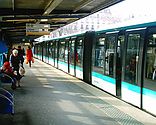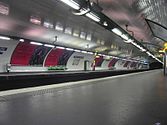사용자:Snowleopard/작업창고/번역수첩2
History[편집]

In November 1898, Paris decided to undertake preliminary work of the metro network with the construction of the first line of the Parisian subway system. Work lasted twenty months under the leadership of engineer Fulgence Bienvenüe and was financed by the municipality of Paris. The line was divided into eight parts distributed between several companies. On 19 July 1900, the line was opened between Porte Maillot and Porte de Vincennes to connect the various sites of the World Fair. Only eight stations were finalized and opened with the inauguration; ten more were gradually opened between 6 August and 1 September 1900. The line followed the east-west monument axis in Paris. These eighteen stations were entirely built under the control of engineer Fulgence Bienvenüe, the majority of them 75 metres long and 4.10 metres wide. In March 1934, the first extension into the suburbs brought service to Château of Vincennes towards the east.
Chronology[편집]
- July 19, 1900: Inauguration of line 1 between Porte de Vincennes and Porte Maillot. Only 8 of the 18 planned stations were opened.
- August 6 and September 1, 1900: The other 10 stations of the line opened.
- March 24, 1934: The line was extended to the east from Porte de Vincennes to the castle of Vincennes.
- November 15, 1936: Porte Maillot station was rebuilt in order to allow a further extension of the line to the west.

A line 1 train near Pont de Neuilly - April 29, 1937: The line was extended to the west from Porte Maillot to Pont de Neuilly.
- 1963: The rails were converted in order to accommodate rubber-tyred trains. At the same time, stations were enlarged in order to accommodate 6-car trains instead of 5-car trains.
- April 1, 1992: The line was extended again to the west from Pont de Neuilly to La Défense business district.
Future[편집]
It is planned to convert the line to a fully automated system (similar to Line 14) by the end of 2010.[1] It will be the first heavy duty line to be converted without interrupting traffic, with both automatic (MP 05) and manual (MP 89 CC) rolling stock running simultaneously till enough automatic rolling stock is available, thanks to the SAET system.
A western extension of Line 1 from La Défense station to the center of Nanterre is being considered. An eastern extension to Rigollots and later to Val de Fontenay is also being investigated.
Facts[편집]
Because of less advanced building techniques of the 1900s, Line 1 of the Paris metro is the closest line to the surface; many stations have a steel beam structure with both arched and beam sections maintaining the large station roof. The line was constructed using the "cut and cover" method and, as a result, follows the line of the streets above. This was done to both facilitate construction and avoid the adjacent buildings' cellars. Bastille station is located above the tunnel entrance of the Canal Saint-Martin, just below the pavement of the Place de la Bastille.
Unlike older trains on other lines, the cars of line 1 trains are all interconnected, allowing people to move between cars. This reduces the number of seats per car and increases standing room.
Despite being almost entirely underground (except Bastille station and for the Seine-crossing at Pont de Neuilly), Line 1 is fully covered by mobile phone networks.
The original stations built on line 1 had platforms the standard 75 metres in length suitable for 5-car trainsets. From 1928, newly constructed stations were built to 105 metres to accommodate 7 cars trains in the future, a plan that has never been realised. Original station platforms were lengthened to 90 metres between 1961 and 1964 for 6 car trains and conversion to rubber-tyred operation.[2]
Map and Stations[편집]


Stations renamed[편집]
- May 27, 1920: Alma station renamed George V.
- May 5, 1931: Reuilly station renamed Reuilly-Diderot.
- May 20, 1931: Champs-Élysées renamed Champs-Élysées - Clemenceau.
- April 26, 1937: Tourelle renamed Tourelle – Saint-Mandé.
- October 6, 1942: Marbeuf renamed Marbeuf - Rond-Point des Champs-Élysées.
- October 30, 1946: Marbeuf - Rond-Point des Champs-Élysées renamed Franklin D. Roosevelt.
- May 25, 1948: Obligado renamed Argentine.
- 1970: Étoile renamed Charles-de-Gaulle - Étoile.
- 1989: Palais Royal renamed Palais Royal - Musée du Louvre after the entrance to the museum was moved with the building of the Louvre Pyramid. At the same time, Louvre station renamed Louvre - Rivoli.
- 1997: Grande Arche de la Défense station renamed La Défense.
- July 26 2002: Saint-Mandé - Tourelle renamed Saint-Mandé.
Tourism[편집]
Line 1 passes near several places of interest:
- La Défense Paris high-rise district which is dominated by the Grande Arche.
- The Arc de Triomphe at Charles de Gaulle-Étoile. A 289 step staircase is open to the public and leads to the top of the Arch. There is also a museum on the top floor.
- L'Avenue des Champs-Élysées.
- The Place de la Concorde dominated by the Obelisk, Tuileries garden and Louvre museum.
- The Louvre station has copies of works of art from the museum and has historical information. The station's benches are made of glass and the Western portal has Roman-inspired arches along the platform edge.
- The Hôtel de Ville (Paris City Hall) and the Marais district.
- Bastille and the nearby Opera.
- Gare de Lyon train station.
- The Place de la Nation.
- The Bois de Vincennes (Vincennes Wood) and Vincennes Zoo.
- The Château de Vincennes. A medieval castle to the east of Paris.
Gallery[편집]
-
Bastille station
-
MP 89 at Pont de Neuilly
See also[편집]
References[편집]
- ↑ “New section of Metro Line 14 opened”. InfraSite.net. 2007-07-02. 2007년 7월 6일에 확인함.
- ↑ Hardy, B. Paris Metro Handbook, 3rd edition, Capital Transport Publishing, 1999.







